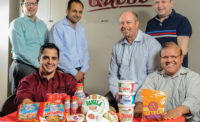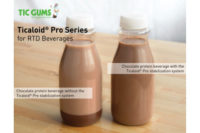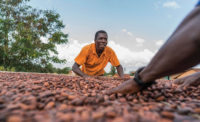

A company with 125 years of history, Kroger went about becoming the mammoth it is rather quietly. There were lengthy periods of organic expansion in the east and the Midwest, followed by a series of acquisitions executed by both the home office in Cincinnati and the Fred Meyer supermarket chain with which it merged in 1999. Nowadays, nobody but Wal-Mart bags more groceries than Kroger, and within those sacks are a heck of a lot of dairy products.
Like many captive dairies, Kroger’s operation flies a bit under the radar. Financials are not reported separately, there is not the kind of brand building associated with a Dreyer’s, a Dannon or even a Dean Foods. Top executives don’t often appear on the cover of magazines, and they don’t come and go frequently. But anyone who’s been in the dairy business long enough the see the Class 1 price rise and fall a couple of times, knows of Kroger Dairy’s reputation. Top executives at Kroger lend their leadership to industry organizations like MilkPEP and IDFA.
In 1983 Kroger Dairy was chosen Processor of the Year by our predecessor Dairy Record, when Kroger was called “A builder of plants.” That was back before Wal-Mart and before the consolidation of the grocery and food manufacturing industries. When we look at Kroger now, one of the things we see is the meeting of East and West. Two substantial organizations were made one back in 1999-one that stretches from sea to shining sea.
Rather than building new facilities, Kroger has spent the last decade or so building a better Kroger. A continuous improvement program based on a platform of three interdependent priorities-Safety, Quality and Reliability-has been the crux of Kroger Corporation’s cultural development since 1997. The results are manifold, but most noticeable is a safety record that has garnered industry and government praise.
Kroger is also redoubling its brand building and product innovation efforts. It has made a commitment to offering organic products and other kinds of foods today’s consumers want more of. And, it is working to implement sustainable business practices, and help build a better way to do business.
In short, today’s Kroger is a Kroger you may have never met before.
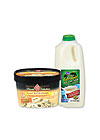
SQR
All successful companies stress employee safety, but at Kroger, safety truly gets top billing.“We don’t start a conversation without talking about safety, because nothing we do is worth getting hurt over,” says Kroger’s pres. of manufacturing William Boehm.
“We truly feel no one should have to come to work at Kroger and worry about whether or not they will go home in the same condition they were in when they got here.”
Boehm’s comment makes specific reference to the first of four Kroger principles on safety:
To Kroger management and associates these are mantras. They are visible in the dairy plants and they are audible in the conversations of the people who operate them. Again, most companies would agree that nothing good comes from injury and accidents. But what is unique about Kroger is that it has linked safety to the bottom line propositions like productivity and reliability to ensure that safety is not pitted against those concerns. There is buy-in from all associates, and the results have been significant, with injury rates being decreased by more than 75%, says Mike Nosewicz, v.p. of dairy manufacturing, East.
“We’ve gotten passionate about SQR,” Nosewicz says. “As reliability improves you get delivery on safety and you get delivery on quality. If the line doesn’t go down it’s running more efficiently, and on the safety side people are not running around trying to get back on schedule. On the quality side, if you don’t have a lot of up and down time, you are more likely to be running on spec.”
In October, Kroger Manufacturing was named one of the safest companies in America by a leading safety, health and loss prevention magazine.
Kroger dairies have also been recognized by IDFA for their safety record.
“Our associates manage the safety process”, Nosewicz says. “It’s really something that’s everyone’s responsibility.”
When Kroger began its journey toward improvement it partnered with a consultant, Competitive Solutions Inc.
Another group, a behavioral-based safety consultant helped develop approaches that were specific to developing a culture of safe behavior.
The SQR program involves a lot of meetings by a lot of different teams, but mostly it provides accountability measures. (For a detailed description of how it works in a plant see the accompanying plant features that begin on page 56.)
Boehm, who joined Kroger in 1981 as an economist, credits his predecessor at the manufacturing helm, Geoff Covert with having launched the continuous improvement program.
“Like any organization, we, for many years struggled with continuous improvement,” Boehm says. “It became a matter of which book you read last month-the flavor of the month so to speak. Our employees never had a single message they could get behind for very long.”
But the SQR platform was something they got beyond and something Kroger stuck with, Boehm adds.
“We’ve been at this for about 10 years and I think we are still only about 50% there. We’ve got it into our heads and now we have to get it into our hearts. We have been recognized for our safety record and we are delighted, but we won’t be finished talking about safety until we get to zero recordable incidents and keep it that way for a long time.”
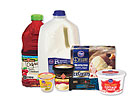
Kroger history
Kroger holds the No. 1 or No. 2 market position in 38 of its 44 major markets. It employees more than 300,000 people, and it operates 42 manufacturing plants. It didn’t get this big overnight.According to Kroger Co. lore, it all began in 1883, when Barney Kroger, the son of a Cincinnati merchant invested $372 to open a grocery store at 66 Pearl Street, in downtown Cincinnati. He adopted a simple motto: “Be particular. Never sell anything you would not want to buy yourself.”
Many aspects of the company’s business today, including its manufacturing capabilities trace their roots to Barney Kroger’s early efforts to serve his customers.
In the early 1900s, most grocers bought their bread from independent bakeries. But Kroger recognized that if he baked his own bread, he could reduce the price for his customers and still make money. So he became the first grocer in the country to establish his own bakeries. He was also the first to sell meats and groceries under one roof.
That carries over into the thinking of manufacturing executives in the 21st Century, who say manufacturing has always been part of Kroger’s model.
“With dairy in particular, people ask me why Kroger would do something like this that’s so far apart for our core competency, but we would take issue with that assumption,” Boehm says. “I’ve heard people say that Kroger really started when Barney Kroger took a loaf of bread from his mother’s kitchen and sold it in his store.”
By 1908, when the company celebrated its 25th anniversary, Kroger had 200 horses and wagons making deliveries and a chain of more than 130 stores in Ohio and northern Kentucky. By 1929 Kroger was operating 5,575 stores-the most in its history.
Sales topped $1 billion in 1952. Three years later the company joined six others to form the Top Value Stamp Co. In 1959 Kroger built a new skyscraper at 1014 Vine Street, which continues to serve as the corporate headquarters today. In 1972, Kroger became the first grocery retailer in America to test an electronic scanner. A year later the company opened its first supercenter.
Annual sales reached $5 billion in 1975, and $10 billon five years later.
In 1983, as Kroger marked a century in business, it merged with Dillon Companies Inc. in Kansas to become a coast-to-coast operator of food, drug and convenience stores.
Fred Meyer history and merger
Fred Meyer, originally of New York City, opened his first public market in downtown Portland, Ore. in 1922. In 1975, after several decades of growth in the Portland area, Fred Meyer purchased the Pacific Northwest-based Valu Mart.On September 2, 1978, Meyer died at the age of 92, and four years later, the company was purchased by Kohlberg Kravis Roberts in a leveraged buyout.
In 1985 Fred Meyer Inc. acquired Grand Central of Salt Lake City, Utah, and converted its stores to the Fred Meyer banner. Acquisitions in the 1990s included Smith’s Food and Drug of Utah, and the Ralph’s Grocery Co. of Los Angeles, catapulting Fred Meyer into the No. 4 spot among U.S. grocery chains by 1998.
When Kroger acquired Fred Meyer in 1999 it was a $13 billion deal that created a supermarket chain with the broadest geographic coverage and widest variety of formats in the food retailing industry. The merger generated huge economies of scale in purchasing, manufacturing, information systems and logistics. In an era when many larger mergers failed, the success of the Kroger-Fred Meyer is something the company is proud of.
Kroger has made some smaller acquisitions since, and it has exited some markets and consolidatated stores, but as it stands today it is the third-largest general retailer in the country, behind Wal-Mart and The Home Depot.
The Fred Meyer merger also enhanced Kroger’s food manufacture capabilities. While it was never near the scope of Kroger’s, the Fred Meyer dairy operation was listed at No. 36 in the Dairy 100 at the time of the merger, with seven plants and an estimated $410 million in annual sales.
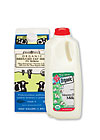
Two heads better than one
The Fred Meyer merger had a major impact in the development of the Dairy Group as it operates today. Most of the acquired dairy operations offered good synergies. Fred Meyer had many large, newer plants in the western states, and Kroger had many facilities where Fred Meyer did not. It took a couple years, but ultimately the operations were organized as two divisions designed to operate as one.“We looked at it and said ‘how do you organize it’? Our conclusion was that 19 dairies was too large a piece for one person with the sort of hands on management that we do,” Boehm says. “What’s made it work are those two executives.”
Nosewicz was recruited by Kroger in 1979 after more than 10 years with A&P. He has been in Kroger’s manufacturing for all of his tenure, and with the dairy group for 23 of the 28 years.
Tim Kelbel, started his career with Borden in 1971, and was a Kroger sales and operations veteran by the time of the Fred Meyer merger. He came back to dairy in 2003 to steer the division along with Nosewicz. Both men work from Cincinnati, where colleagues refer to them as the yin and yang of the dairy group.
“Those two guys manage what on paper is two separate organizations as if they were a single entity,” Boehm says. “That’s unusual in my experience. It takes two executives who are unselfish enough to make compromises for the good of the operation.”
Kelbel handles the western facilities and also operates Inter-American Products, the co-manufacturing arm of Kroger’s manufacturing division.
“For the last four years, we have been integrating the Fred Meyer, Ralphs and Smith’s operations into the SQR,” Kelbel says. “The western plants were behind the curve when they came in, obviously, but they’ve done a really great job. Mike and I really work closely together so that we have a seamless, continuous dairy system for our company.”
Inter-American is a crucial part of Kroger manufacturing, and is run as a stand-alone subsidiary. It manufactures products in 56 different segments from 36 of Kroger’s 42 food plants, including all of the dairies.
“We’re customer focused, and we have three sales areas: retail grocery; convenience stores, drugstores and mass merchandisers; and then industrial and co-packing. We’re set up so that our sales leaders can walk into a company and basically be able to represent all 56 commodities,” Kelbel says. “We do a lot of business in these areas from doing co-brands for non-affiliated retailers to ingredients that are used in products that are made by other companies.”
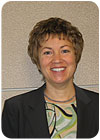
Linda Severin, v.p. of corporate brands, joined Kroger in Jan. 2007 from ConAgra Foods Inc. in Chicago where she served as v.p. of marketing. She has held leadership positions at Campbell’s, Dean Foods, Sara Lee and Rand McNally. Severin earned a bachelor’s degree from Tufts University and a master’s of business administration in marketing from the University of Michigan.
Reinventing the store brand
Linda Severin came to Kroger with a lengthy resume in food product development that include the likes of ConAgra Foods, Campbell’s, Dean Foods and Sara Lee.Private label makes up the vast majority of Kroger’s offerings in a given store, and has always been an important part of the company’s business proposition. When Severin joined Kroger in January as v.p. of corporate brands, it was the latest evidence that Kroger wants to take its product innovations to the next level.
“Putting our customers first is the fundamental priority,” at Kroger, Severin says. “We come at it from the perspective that we want to give them what they want and then some.”
Most recently, that “then some” took the form of a milk designed to reduce cholesterol. Active Lifestyles milk provides cholesterol reduction through the inclusion of Corowise plant sterols.
“Something like 100 million people across the country suffer from borderline to high cholesterol so we saw this as an opportunity to offer customers something through our dairy group that could actually help them address a health concern,” Severin says. “We really worked hand-in-hand with the dairy group and with our supplier Cargill and we had a cross functional team that included everyone from dairy department managers to customers and operations people.”
The product launched in June after many months of development.
“It rolled out across the country in the majority of the stores,” Severin says. “There was a small regional brand in Texas that had something similar, but this was the first product of its kind that was launched nationwide, so it was a very innovative thing for our company and very exciting.”
The dairy group recently introduced pints for ice cream, after consumer research showed that the same consumer will purchase larger formats and pints for different occasions.
More innovations are in the works, Severin says, and dairy will play a big role. Kroger brands will be in the mix as consumers look for things like functional foods, natural foods, organics and locally produced foods in the aisles of Kroger stores.
Kroger green
While rival Wal-Mart has gotten lots of attention for its ambitious initiatives to offer organic products and to green-up its operations, Kroger is continuing and expanding similar efforts. The company says it has reduced its annual electricity consumption by 1 billion kilowatt-hours. A new store, opened in March in Ohio, takes conservation a step further. Features include 100 6-foot skylights, light sensors located on the roof and inside the store control overhead lighting as needed. Energy-efficient T-8 fluorescent tube lighting and motion-sensing switches turn off lights in all the work areas behind the counters. Exhaust fumes from the frozen-food freezers are directed into a heat recovery system for heating water.Kroger Bringing Organic Products to the Store's Center
CINCINNATI-Organics is nothing new for Kroger, but late this year the company began expanding its line of organic foods with the idea of making it easier for customers to find organic products throughout the store.Kroger’s expanded organics line is being sold under its exclusive Private Selection brand and includes more than 60 products such as pasta, waffles, tea, peanut butter, snacks and milk.
“Kroger offers a range of organic products, and they have been trickling into the stores for over a year,” says Linda Severin, v.p. of corporate brands. “In August we announced the launch of our Private Selection Organic line which by then included 67 items across the store, including produce, dairy, bakery, deli and grocery. By the end of January we expect to double that number.
“There is a large group of our shoppers who are interested in making smart food choices. They may not be fully involved in that lifestyle or have the money to go to a specialty, but our Private Selection Organic products are throughout the store right there with all the conventional selections, so they can make those decisions on a case by case basis.”
Severin says Kroger’s research indicated that the dairy case is often where shoppers first try organic, so Kroger has increased its organic milk offerings and now packages its own private label organic milk.
Kroger’s Private Selection Organic line is offered in addition to its Naturally Preferred natural and organic foods line, first introduced five years ago. Kroger and its family of stores offer over 300 Naturally Preferred brand items, including baby food, cereal, snacks and soy products. These products are minimally processed and use all natural and organic ingredients. Many of these products are also organic and contain ingredients that are certified organically grown and free of herbicides and pesticides.
Kroger operates a store-within-the-store concept, Natures Markets, at about half of its 2,450 stores.
“That’s for the more committed customers for organic and natural lifestyle,” Severin says. “It meets the majority of their shopping needs.”
William Boehm, Kroger’s pres. of manufacturing, says organic foods, natural and locally grown foods are becoming more important for Kroger and all of its banner supermarkets.
“Organics is an area of growing interest among consumers,” Boehm says. “But I think it goes beyond organics to things like local supply, and consumers having more knowledge about their food and how it is produced, and we need to be in position to provide that everywhere not just in certain store formats.”
The Kroger Dairy Group might also begin manufacturing other organic dairy products like ice cream, or yogurt, Severin said.
